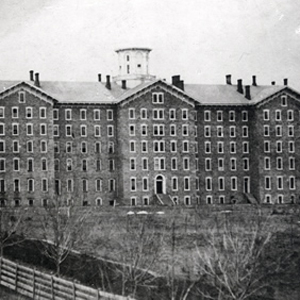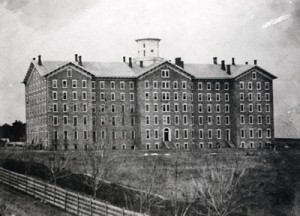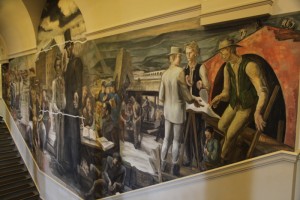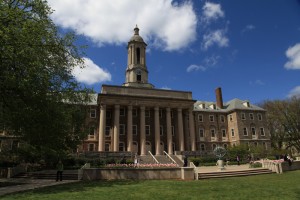
Old Main has been a prominent landmark for the Penn State University Park campus for many years. On cold winter nights, you can find students catching snowflakes on its lawn, and in the spring a good game of Frisbee. It also is one of the most photographed places in University Park, second only to the Lion Shrine. The path Old Main took through its 150 year history was riddled with obstacles, fires, and rebuilds, but the building still holds the same symbol of Penn State pride.
1855: Upon receiving its charter, Penn State (Farmers High School of Pennsylvania) chose Hugh McAllister to design a “Main Building,” which he did after Princeton University’s famous Nassau Hall and was set to include student residences, lecture halls, office space, a chapel, a library, and rudimentary science libraries.

1857: Construction started two years before the first classes began, but the short economic crisis during this time prevented the new college from collecting money from pledges making it impossible to finish building in time.
1859: 69 students moved in and arrived for classes when only the west wing of the building was finished.
1861: Penn State President Evan Pugh, convinced the Pennsylvania state legislature to allot the $50,000 needed to finish the “Main Building,” allowing construction to resume.
1863: The “Main Building” was fully opened but was still very primitive even by today’s standards. It included oil lamps for candle light, water fetched from wells, and coal-fire furnaces in the basement.
1887: The building was remodeled and included electric lights and central steam heat.
1892: After a fire razed part of the building, Penn State hired J. Robert Cole, an architect and builder to remodel the upper section of the building. The remodel included a new Gothic-style roof and clock tower, although a bit of mystery surrounds the story of the bell. Documents show that the bell was ordered from the West Troy (New York) Foundry, but if you visit the current one on campus today, the bell you will see was cast by the Boston foundry of the William Blake and Company. What happened to the West Troy bell is still lost in history.
1904: The class gift of 1904 was a new bell for the “Main Building.” During this time, students and faculty started calling the “Main Building” “Old Main” because it was literally falling apart.
1928: Old Main had so many problems that only the president’s and administrative offices were housed in it, and students no longer resided there. It eventually had to be completely torn down and rebuilt.
1930: Old Main was reopened after Charles Z. Klauder remodeled it. Some of the original stone and embodiment of the building was kept, including the bell. The new addition incorporated eight limestone pillars facing College Avenue, symmetrical walk ways, and 30 elm trees.
1940-1949: Old Main became home to Henry Varnum Poor’s land-grant frescoes, which depict Penn State’s founding and early development through murals.

1955: Old Main soon became a large part of students’ life and no longer served as just an administrative building. It included a dispensary, rehearsal room for theatre students, student lounge, sandwich shop, ticket sale booth for shows and athletic events, and even housed the Collegian for a while.
1969-1970: Old Main quickly became a place of protest since it strictly housed administrators by this time. Students came to protest the war, racism, and social injustice among other things.
Today: Old Main remains an administrative building, but is still regarded as one of the most famous structures that embodies the very heart and soul of Penn State. From its humble beginnings of serving as a building for all University operations through its various renovations and purposes, Old Main stands as a reminder of Penn State’s history and traditions. It symbolizes the roots, legacy, hard work, and undying pride of the institution.

